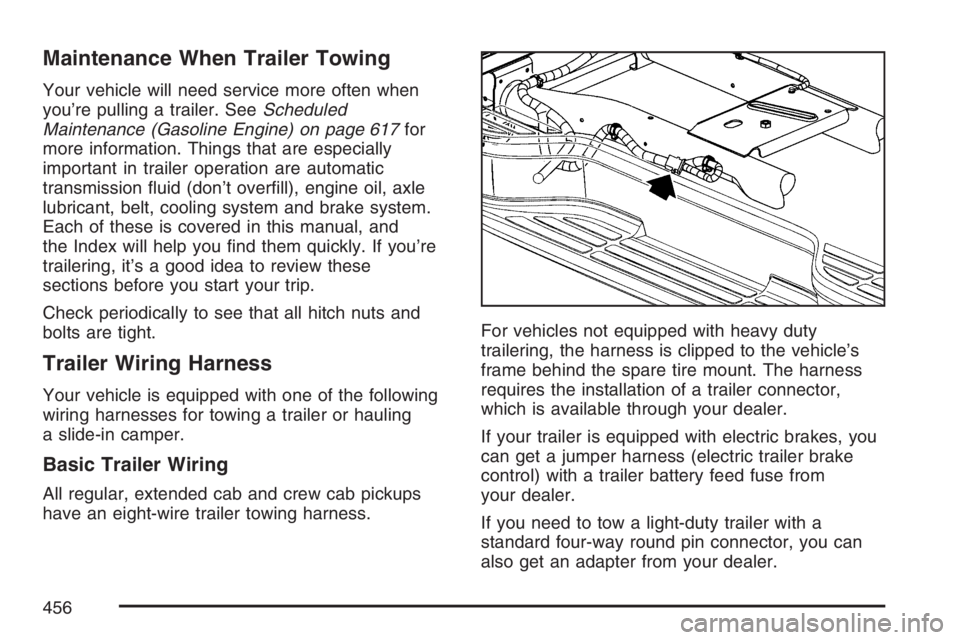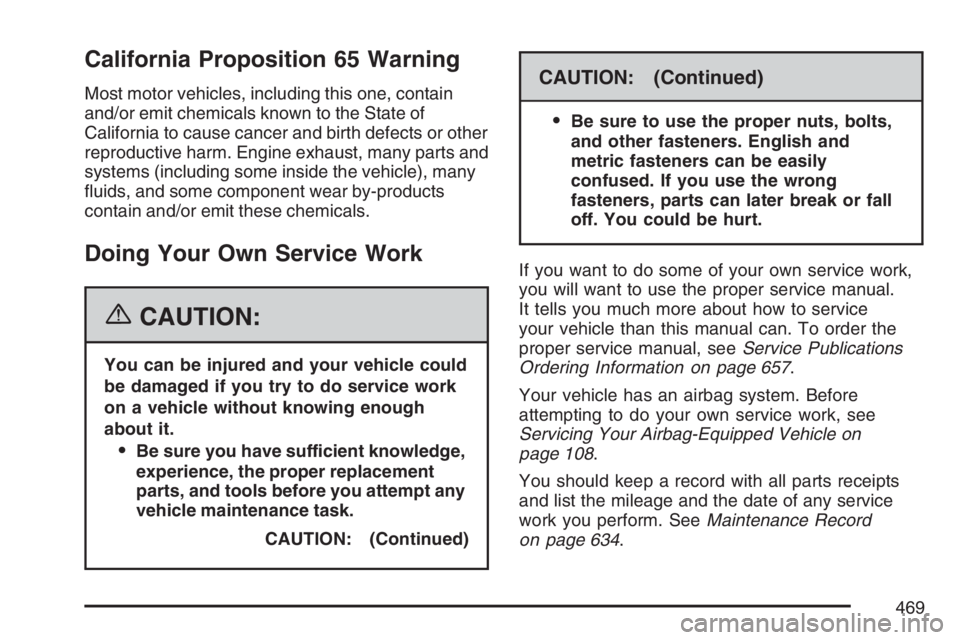Page 456 of 674

Maintenance When Trailer Towing
Your vehicle will need service more often when
you’re pulling a trailer. SeeScheduled
Maintenance (Gasoline Engine) on page 617for
more information. Things that are especially
important in trailer operation are automatic
transmission �uid (don’t over�ll), engine oil, axle
lubricant, belt, cooling system and brake system.
Each of these is covered in this manual, and
the Index will help you �nd them quickly. If you’re
trailering, it’s a good idea to review these
sections before you start your trip.
Check periodically to see that all hitch nuts and
bolts are tight.
Trailer Wiring Harness
Your vehicle is equipped with one of the following
wiring harnesses for towing a trailer or hauling
a slide-in camper.
Basic Trailer Wiring
All regular, extended cab and crew cab pickups
have an eight-wire trailer towing harness.For vehicles not equipped with heavy duty
trailering, the harness is clipped to the vehicle’s
frame behind the spare tire mount. The harness
requires the installation of a trailer connector,
which is available through your dealer.
If your trailer is equipped with electric brakes, you
can get a jumper harness (electric trailer brake
control) with a trailer battery feed fuse from
your dealer.
If you need to tow a light-duty trailer with a
standard four-way round pin connector, you can
also get an adapter from your dealer.
456
Page 459 of 674
Electric Brake Control Jumper
{CAUTION:
Be sure to use only the correct trailer
brake harness, the one intended for use
on your vehicle. If you use some other
trailer brake harness, even if it seems to
�t, your trailer brakes may not work at all.
You could have a crash in which you or
others could be injured. Use only the
trailer brake harness intended for your
vehicle. If it is no longer available to you,
be sure to get a proper replacement from
your dealer.This harness is included with your vehicle as part
of the heavy-duty trailer wiring package.
This harness is for an electric brake controller and
includes a trailer battery feed fuse. It should be
installed by your dealer or a quali�ed service
center.
459
Page 460 of 674

Auxiliary Battery
The auxiliary battery provision can be used to
supply electrical power to additional equipment that
you may choose to add, such as a slide-in camper.
If your vehicle has this
provision, this relay will
be located on the
passenger’s side of the
vehicle, next to the
auxiliary battery.
When using this provision, connection should only
be made to the upper stud (A) of the relay. Do not
make connections to the lower stud (B) of the relay.
The auxiliary battery circuit is protected by a
megafuse located behind the auxiliary battery.
Be sure to follow the proper installation instructions
that are included with any electrical equipment
that you install.Notice:Leaving electrical equipment on for
extended periods will drain the battery. Always
turn off electrical equipment when not in
use and do not use equipment that exceeds
the maximum amperage rating for the auxiliary
battery provision.
Power Winches
If you wish to use a power winch on your vehicle,
only use it when your vehicle is stationary or
anchored.
Trailer Recommendations
You must subtract your hitch loads from the CWR
for your vehicle. Weigh your vehicle with the
trailer attached, so that you won’t go over
the GVWR or GAWR. If you are using a
weight-distributing hitch, weigh the vehicle without
the spring bars in place.
You’ll get the best performance if you spread out
the weight of your load the right way, and if
you choose the correct hitch and trailer brakes.
For more information, seeTowing a Trailer
on page 429.
460
Page 467 of 674

Washing Your Vehicle............................... 592
Cleaning Exterior Lamps/Lenses................ 593
Finish Care............................................... 593
Windshield and Wiper Blades.................... 594
Aluminum or Chrome-Plated Wheels......... 594
Tires......................................................... 595
Sheet Metal Damage................................. 595
Finish Damage.......................................... 596
Underbody Maintenance............................ 596
Chemical Paint Spotting............................ 596
Vehicle Care/Appearance Materials............ 597
Vehicle Identi�cation.................................. 598
Vehicle Identi�cation Number (VIN)........... 598
Service Parts Identi�cation Label............... 598Electrical System........................................ 599
Add-On Electrical Equipment..................... 599
Windshield Wiper Fuses............................ 599
Power Windows and Other Power
Options.................................................. 599
Fuses and Circuit Breakers....................... 600
Instrument Panel Fuse Block..................... 600
Center Instrument Panel Fuse Block......... 602
Underhood Fuse Block.............................. 603
Capacities and Speci�cations.................... 609
Section 5 Service and Appearance Care
467
Page 469 of 674

California Proposition 65 Warning
Most motor vehicles, including this one, contain
and/or emit chemicals known to the State of
California to cause cancer and birth defects or other
reproductive harm. Engine exhaust, many parts and
systems (including some inside the vehicle), many
�uids, and some component wear by-products
contain and/or emit these chemicals.
Doing Your Own Service Work
{CAUTION:
You can be injured and your vehicle could
be damaged if you try to do service work
on a vehicle without knowing enough
about it.
Be sure you have sufficient knowledge,
experience, the proper replacement
parts, and tools before you attempt any
vehicle maintenance task.
CAUTION: (Continued)
CAUTION: (Continued)
Be sure to use the proper nuts, bolts,
and other fasteners. English and
metric fasteners can be easily
confused. If you use the wrong
fasteners, parts can later break or fall
off. You could be hurt.
If you want to do some of your own service work,
you will want to use the proper service manual.
It tells you much more about how to service
your vehicle than this manual can. To order the
proper service manual, seeService Publications
Ordering Information on page 657.
Your vehicle has an airbag system. Before
attempting to do your own service work, see
Servicing Your Airbag-Equipped Vehicle on
page 108.
You should keep a record with all parts receipts
and list the mileage and the date of any service
work you perform. SeeMaintenance Record
on page 634.
469
Page 481 of 674

A. Engine Air Cleaner/Filter. SeeEngine Air
Cleaner/Filter (Gasoline Engines) on page 491.
B. Coolant Surge Tank and Pressure Cap. See
Engine Coolant on page 502andCoolant
Surge Tank Pressure Cap on page 505.
C. Air Filter Restriction Indicator (If Equipped).
SeeEngine Air Cleaner/Filter (Gasoline
Engines) on page 491.
D. Engine Oil Dipstick. See “Checking Engine Oil”
underEngine Oil (Gasoline Engine) on
page 486.
E. Automatic Transmission Fluid Dipstick
(If Equipped). See “Checking the Fluid Level”
underAutomatic Transmission Fluid (Allison
Transmission
®) on page 494orAutomatic
Transmission Fluid (Except Allison
Transmission
®) on page 497.
F. Engine Cooling Fan. SeeCooling System on
page 508.G. Engine Oil Fill Cap. See “When to Add Engine
Oil” underEngine Oil (Gasoline Engine) on
page 486.
H. Power Steering Fluid Reservoir. SeePower
Steering Fluid on page 515.
I. Remote Negative (−) Terminal (GND). See
Jump Starting on page 521.
J. Remote Positive (+) Terminal. SeeJump
Starting on page 521.
K. Brake Fluid Reservoir. See “Brake Fluid” under
Brakes on page 517.
L. Clutch Fluid Reservoir (If Equipped). See
Hydraulic Clutch on page 501.
M. Underhood Fuse Block. SeeUnderhood Fuse
Block on page 603.
N. Battery. SeeBattery on page 520.
O. Windshield Washer Fluid Reservoir. See
“Adding Washer Fluid” underWindshield
Washer Fluid on page 516.
481
Page 483 of 674

A. Engine Air Cleaner/Filter. SeeEngine Air
Cleaner/Filter (Gasoline Engines) on page 491.
B. Coolant Surge Tank and Pressure Cap. See
Engine Coolant on page 502andCoolant
Surge Tank Pressure Cap on page 505.
C. Air Filter Restriction Indicator (If Equipped).
SeeEngine Air Cleaner/Filter (Gasoline
Engines) on page 491.
D. Engine Oil Dipstick. See “Checking Engine Oil”
underEngine Oil (Gasoline Engine) on
page 486.
E. Automatic Transmission Fluid Dipstick
(If Equipped). See “Checking the Fluid Level”
underAutomatic Transmission Fluid (Allison
Transmission
®) on page 494orAutomatic
Transmission Fluid (Except Allison
Transmission
®) on page 497.
F. Engine Oil Fill Cap. See “When to Add Engine
Oil” underEngine Oil (Gasoline Engine) on
page 486.G. Engine Cooling Fan. SeeCooling System on
page 508.
H. Remote Negative (−) Terminal (GND). See
Jump Starting on page 521.
I. Power Steering Fluid Reservoir. SeePower
Steering Fluid on page 515.
J. Remote Positive (+) Terminal. SeeJump
Starting on page 521.
K. Brake Fluid Reservoir. See “Brake Fluid” under
Brakes on page 517.
L. Clutch Fluid Reservoir (If Equipped). See
Hydraulic Clutch on page 501.
M. Underhood Fuse Block. SeeUnderhood Fuse
Block on page 603.
N. Battery. SeeBattery on page 520.
O. Windshield Washer Fluid Reservoir. See
“Adding Washer Fluid” underWindshield
Washer Fluid on page 516.
483
Page 485 of 674

A. Engine Air Cleaner/Filter. SeeEngine Air
Cleaner/Filter (Gasoline Engines) on page 491.
B. Coolant Surge Tank and Pressure Cap. See
Engine Coolant on page 502andCoolant
Surge Tank Pressure Cap on page 505.
C. Air Filter Restriction Indicator (If Equipped).
SeeEngine Air Cleaner/Filter (Gasoline
Engines) on page 491.
D. Engine Oil Dipstick. See “Checking Engine Oil”
underEngine Oil (Gasoline Engine) on
page 486.
E. Automatic Transmission Fluid Dipstick
(If Equipped). See “Checking the Fluid Level”
underAutomatic Transmission Fluid (Allison
Transmission
®) on page 494orAutomatic
Transmission Fluid (Except Allison
Transmission
®) on page 497.
F. Engine Oil Fill Cap. See “When to Add Engine
Oil” underEngine Oil (Gasoline Engine) on
page 486.G. Engine Cooling Fan. SeeCooling System on
page 508.
H. Remote Negative (−) Terminal (GND). See
Jump Starting on page 521.
I. Remote Positive (+) Terminal. SeeJump
Starting on page 521.
J. Power Steering Fluid Reservoir. SeePower
Steering Fluid on page 515.
K. Brake Fluid Reservoir. See “Brake Fluid” under
Brakes on page 517.
L. Clutch Fluid Reservoir (If Equipped). See
Hydraulic Clutch on page 501.
M. Underhood Fuse Block. SeeUnderhood Fuse
Block on page 603.
N. Battery. SeeBattery on page 520.
O. Windshield Washer Fluid Reservoir. See
“Adding Washer Fluid” underWindshield
Washer Fluid on page 516.
485